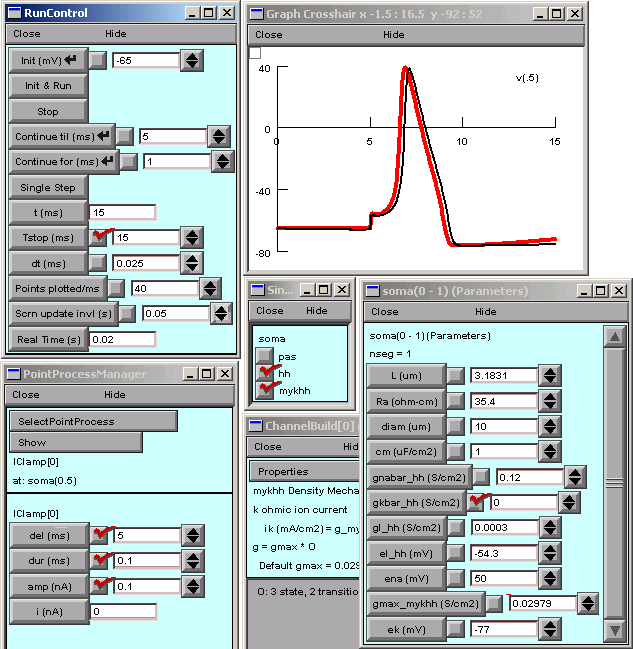
Comments
- This simple test does little to compare the subthreshold behavior of the HH and mykhh potassium currents. Some mismatch is already apparent, e.g. using the mykhh mechanism results in a slight initial drift of resting potential because the ionic currents don't quite cancel at -65mV. When tinkering with the relative abundance of ion channels, it's always a good idea to be careful about initialization. At the very least, let things have some time to settle toward its new resting potential (assuming the model isn't spontaneously active). Better yet, use a custom initialization (force a resting potential, or allow the model to settle to rest or a new stable trajectory before t = 0).
- Slight adjustment to the parameters of the mykhh mechanism can improve the match between the mykhh spike and the standard HH spike. This is probably best done in the context of the original hands-on exercise (see http://www.neuron.yale.edu/neuron/courses.html for a link to the summer course files -- look at the exercise called
NMODL : Kinetic Scheme : potassium channel ).- Consider the possibility that improving the match between the HH and the "mykhh" spikes may not necessarily improve the match between the subthreshold dynamics of these two mechanisms. Which counts more in shaping the integrative properties of a cell the subthreshold dynamics of its currents, or their ability to generate a spike with a particular waveform?
- After all that dour stuff, how about a little fun?
Bring up the ChannelBuilder's GateGUI (click on "O: 3 state, 2 transitions" in the bottom panel of the ChannelBuilder).
Make sure the GateGUI tool's "Display inf,tau" and "Run" checkboxes are both checked.
Now drag the tauC1C2 curve's control point around and see what happens to its A and d parameters and the spike waveform.
Also try the infC1C2 curve's control point (it only moves left and right).
You can try to change the k parameters by clicking near the control points, but it's tricky -- you'll have much better control by direct entry into their numeric fields or by using the adjacent spinners.
This is a link to testmykhh.hoc, which you can use to recreate this figure (it's actually a session file, but its extension has been changed to "hoc" to make it runnable from the WWW). Both this file and the fully configured mykhh.ses are packaged with the zipped archive of this tutorial.
Copyright © 2004-2006 by N.T. Carnevale and M.L. Hines, All Rights Reserved.